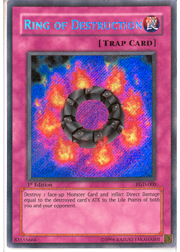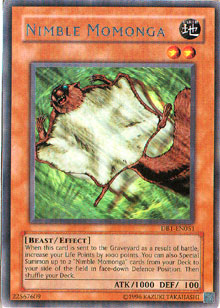Before getting too involved in today’s edition of The Binder, I have to apologize to Joe Hletko for calling him John all throughout last week’s article. I guess I wasn’t savvy enough in the Yu-Gi-Oh! universe to check out Metagame.com’s splendid Shonen Jump Championship live coverage closer. Sorry about that, Joe!
Another disappointing part of last week’s analysis on Ceasefire was that it was posted after the changes were announced to the advanced format. This meant that I was suggesting tech for a format that is just about done. I’d be a little miffed at this if it weren’t for the fact that Ceasefire is still a powerful card in the upcoming advanced format. Being able to aggressively take down the opponent’s life points is definitely going to be a plus.
 Aggro’s rise in power is pretty easy to predict. One of the most aggressive cards ever made, Ring of Destruction, has been legalized for advanced format tournament play once again. A control player can look at this card and ponder how the life point damage will potentially hurt himself or herself late in a duel. An aggro player can look at Ring of Destruction and say, “Oh joy! I get to defeat my opponent a turn early!” The card’s release has aided aggro’s ascent into tournament play, and with the aid of other massive burn cards such as Ceasefire, Magic Cylinder, and the recently unlimited Reflect Bounder, aggro/burn variants can see heavy play for the first time in a while.
Aggro’s rise in power is pretty easy to predict. One of the most aggressive cards ever made, Ring of Destruction, has been legalized for advanced format tournament play once again. A control player can look at this card and ponder how the life point damage will potentially hurt himself or herself late in a duel. An aggro player can look at Ring of Destruction and say, “Oh joy! I get to defeat my opponent a turn early!” The card’s release has aided aggro’s ascent into tournament play, and with the aid of other massive burn cards such as Ceasefire, Magic Cylinder, and the recently unlimited Reflect Bounder, aggro/burn variants can see heavy play for the first time in a while.
With aggro’s inevitable increase in tournament play, the focus of competitive play in Yu-Gi-Oh! TCG will probably shift. Players who spend time hoarding cards are going to see the painful side of a newly summoned Sillva, Wu-Lord of Dark World, or a newly flipped Ceasefire. Denying your opponents options is important in the control matchups, but when it comes to playing an aggro deck, denying your opponents whole turns is far more important. Likewise, combo decks of the Chimeratech Overdragon variety don’t particularly need to deal damage every turn. They just give the opponent a limited number of turns to win and then defeat him or her with a field of five mechanical horrors.*
Concerns about being beat in the tempo race against an aggro deck makes life points, once again, a much more valuable commodity. Likewise, the Chimeratech combo deck needs to deal more than a fair share of damage in its one turn in order to defeat you. This is where Nimble Momonga comes in, annihilating any form of tempo your opponent was trying to gain on you.
 Nimble Momonga has always been a potentially devastating little monster. It has the ability not only to increase your now-precious life point total when it is destroyed as a result of battle, but it also gives you increased field presence. The total possible gain that Nimble Momonga can provide is an impressive 3000 life points, but that alone wouldn’t be enough to make it truly worthwhile. The fact that it also replaces itself with two more Nimble Momonga cards is incredible.
Nimble Momonga has always been a potentially devastating little monster. It has the ability not only to increase your now-precious life point total when it is destroyed as a result of battle, but it also gives you increased field presence. The total possible gain that Nimble Momonga can provide is an impressive 3000 life points, but that alone wouldn’t be enough to make it truly worthwhile. The fact that it also replaces itself with two more Nimble Momonga cards is incredible.
An aggro deck’s objective is to have such a fast tempo that you will not be able to go on the offensive at all as a control player. The aggro player’s goal is to defeat you quickly, by any means necessary. Nimble Momonga puts the brakes on that, and there’s not much the aggro player can do about it. Not only does the life gain undo a full turn’s worth of work, but it also requires your opponent to smash his or her way through a field that doubles in size when the initial Nimble Momonga hits the graveyard after battle. This will sometimes buy you, the Nimble Momonga lover, as much as two extra turns, which could be the difference between the aggro-player finishing you off and you gaining control of the duel.
In fact, if you are playing the Chimeratech combo deck, Nimble Momonga will be your best friend for many months. Combo decks need to buy as much time as possible, and getting two extra turns from these little Beasts will usually give you enough time to find the last combo piece you need to win the duel. Another benefit of Nimble Momonga is that it can attack under practically any continuous form of stall. The only competitive cards that can halt a Nimble Momonga assault are Swords of Revealing Light, Nightmare’s Steelcage, and Wall of Revealing Light. This little squirrel laughs at the sight of Gravity Bind and scoffs at the lowly Level Limit - Area B.
 What makes the Nimble Momonga even more obnoxious is the fact that it is one of the most annoying monsters to recycle with Pot of Avarice. Most competitive players know that Pot of Avarice is not only a short and useful burst of cards, but also a useful tool for recycling recruiter monsters and other self-replacing monsters. Nimble Momonga is probably the best trio of monsters you can shuffle back into your deck right now, since it takes the powerful ability of shutting down your opponent’s progress for two turns and gives you that option again! The only thing better than making your opponent waste two turns of work is making him or her waste two more turns of work!
What makes the Nimble Momonga even more obnoxious is the fact that it is one of the most annoying monsters to recycle with Pot of Avarice. Most competitive players know that Pot of Avarice is not only a short and useful burst of cards, but also a useful tool for recycling recruiter monsters and other self-replacing monsters. Nimble Momonga is probably the best trio of monsters you can shuffle back into your deck right now, since it takes the powerful ability of shutting down your opponent’s progress for two turns and gives you that option again! The only thing better than making your opponent waste two turns of work is making him or her waste two more turns of work!
With September 1st and the new advanced format fast approaching, players need to make sure they are running the right cards in the decks of their testing gauntlets. If your Chimeratech combo deck isn’t including a full suite of Nimble Momonga cards and you are having trouble beating aggro decks, then you should probably re-work your deck a little bit to fit these critters in. Nimble Momonga is going to serve many purposes in the next six months, so you better be ready to see it multiplying on your opponent’s field once (or twice) every couple of duels.
If you have any questions or comments regarding this or previous articles of mine, feel free to e-mail me at Mrosenberg@metagame.com.
*The reason I did not mention the Cyber-Stein combo is because I believe it will be a terrible deck choice for the new advanced format. If aggro decks are going to be the most powerful option available, then keeping your life points over 5000 is going to be a difficult task if you want to actually win with your risky and slightly too luck-based Machine monster.